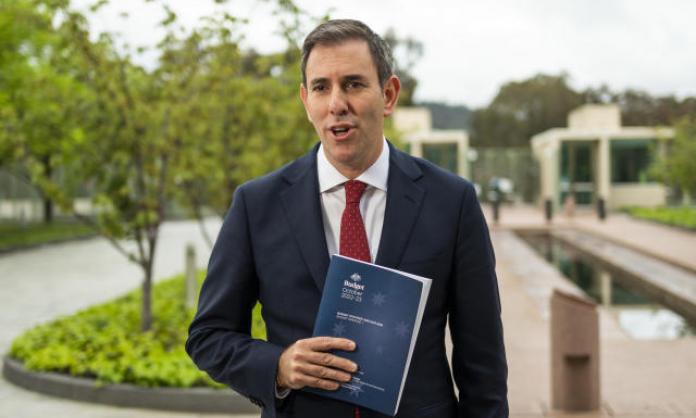Labor’s federal budget throws a few crumbs to those suffering most from the cost-of-living crisis, while otherwise maintaining the status quo of an economy in which—in the decade to 2019—93 percent of the gains from economic growth flowed to the top 10 percent of income earners.
The idea that we should be impressed by $14.6 billion over four years for cost-of-living relief or a $3.5 billion boost to Medicare brings to mind the prison scene from Monty Python’s Life of Brian, in which an old man who has been shackled to the wall of a dungeon for years effuses about the prospect of being spat on: “Oohooh, [what] wouldn’t I give to be spat at in the face? Sometimes I lay awake at night, dreaming of being spat at in the face”.
Chalmers and other Labor ministers claim that they simply didn’t have the money to fund good ideas like a substantial across-the-board increase in JobSeeker payments. The government’s own Economic Inclusion Advisory Committee recently recommended increasing the rate of JobSeeker to 90 percent of the age pension. Instead, the government has increased the payment by just $40 a fortnight, or $2.85 a day, for people under 55.
As Greg Jericho noted in the Guardian, $2.85 extra a day for welfare recipients “is so small it will take people on the benefit from being about 44 percent below the poverty line to about 41 percent below”. It’s a spit in the face.
Increasing JobSeeker to 90 percent of the age pension for everyone would cost an estimated $75 billion over ten years. That amount pales in comparison to the $254 billion hit to government revenue that will result if Labor goes ahead, as it insists it will, with the Stage 3 tax cuts due to kick-in on 1 July 2024. Most of those tax cuts go to the wealthy.
At student climate rallies, one of the popular chants goes: “We’ve got a climate fix: tax, tax, tax the rich!” They’re on to something. If the government ditched the Stage 3 tax cuts for those earning more than $120,000, it would deliver a $189 billion boost to the budget bottom line over the next ten years—enough to fund the recommended increase to JobSeeker with $114 billion to spare.
One of the things we could spend some of that $114 billion on is housing. The budget’s housing package is an insult to all those suffering through the current crisis. Labor and the media are making much of the government’s decision to increase rent assistance by 15 percent—“the largest increase in more than 30 years”, as Chalmers said. The up to $31 extra a fortnight this will provide, however, is less impressive when seen in the light of rent increases that currently often total in the hundreds of dollars a week. And most renters will get nothing at all.
It’s the same story with Labor’s housing plan. The plan, which the government is currently attempting to get through parliament, would invest $10 billion in a “housing future fund”, the earnings from which—up to $500 million a year—will be used to build social and affordable housing.
The Greens have said they will oppose it. They should stick to their guns. It promises the construction of just 30,000 new housing units in the next five years. Calling this is a drop in the ocean would be generous. On the night of the 2021 census, there were an estimated 122,494 homeless people in Australia. In the same year—the latest for which the government has provided data—there were 163,500 households on waiting lists for public housing.
These figures are likely to have increased significantly in the last two years. More recent data, released in April by Homes Victoria, a state government agency, showed Victoria’s public housing waiting list grew by 3,000 in the year to December 2022, reaching a total of 57,672 households. Of these, 36,459 were assessed as being in urgent need.
It’s doubtful that Labor’s plan will even cover the growth in public housing waiting lists over the next five years, never mind doing anything to address the broader affordability crisis.
Were Labor to ditch the Stage 3 tax cuts for those on more than $120,000 a year, it could spend $10 billion on new housing every year for the next ten years and still have money to spare. If it ditched negative gearing and the capital gains tax discount—which overwhelmingly benefit the richest 10 percent and which are estimated by the Parliamentary Budget Office to total $157 billion over the next decade—it could spend $20 billion a year and still have tens of billions left over.
According to a recent report from the Grattan Institute, a think tank, the cost of building new social or public housing units in Australia ranges from $240,000 to $330,000. If, for simplicity, we go with $300,000 per unit, a $20 billion spend would build just short of 67,000 new housing units a year, or 670,000 over ten years.
“Tax, tax, tax the rich!”, as the students say.
Labor could have done this. It chose not to, and people on welfare, the homeless and everyone suffering from the extreme housing crisis we’re currently living through will continue to suffer the consequences.
Another chant popular with student activists goes like this: “Money for health and education, not for mining corporations!” The government is making much of tightened tax arrangements for gas exporters that it estimates will bring in an extra $2.4 billion over the next four years. This is laughable. It’s less, for comparison, than the $3.3 billion the government will receive thanks to a 15.8 percent hike in the tobacco tax (something that will overwhelmingly hit the working class).
There’s nothing in the budget about cutting the $57.1 billion worth of subsidies the Australia Institute estimates will be gifted to the fossil fuel industry over this period. That extra $57.1 billion could have funded a lot more than a modest boost to Medicare. The new, state of the art hospital being built in Footscray, in Melbourne’s west, is to cost $1.5 billion. Cut fossil fuel subsidies, and in four years we could have another 38 of those. Or perhaps we could make do with just 19, and spend the remaining $28.5 billion on giving a much needed boost to the transition to renewable energy.
Then there’s the military. As part of the AUKUS deal between the US, the UK and Australia, the government has announced its intention to spend up to $368 billion over the next 30 years to obtain a fleet of eight nuclear-powered submarines. This is justified by the government on the basis both of supposed “national security” and as a job creation scheme. On neither measure does it stack up.
The AUKUS deal welds Australia even more solidly to the US and its increasingly aggressive attempt to prevent the further emergence of China as a dominant power in the Asia-Pacific. In doing so, it makes war more likely, and with it the direct and potentially catastrophic threat to people in Australia and across our entire region. As well as paying for those nuclear-powered submarines with hundreds of billions of taxpayer funds that could be better spent elsewhere, we may ultimately pay for them with our blood.
On jobs, according to the government’s own figures, AUKUS will result in the creation of just 20,000 over three decades. At a cost of $368 billion, and assuming all jobs run for the full 30 years (they won’t), that’s $613,333 per job, per year. For the same amount, you could hire 70,000 extra nurses and 70,000 teachers for the next 30 years.
Leading up to the budget, the government attempted to deflect criticism by talking as if the “pressures” it faces, and the “heavy lifting” involved, are things over which it has no control. But anyone with half a brain can see that some of the biggest weights foisted on the budget over the long term—like the Stage 3 tax cuts and the AUKUS deal—are there not because of some invisible power beyond the government’s control, but by the conscious decision of Labor itself.
Tax cuts for the rich must stay. The obscene government largesse to the fossil fuel industry must continue. Hundreds of billions must be spent on nuclear-powered submarines. But, due to the need to be “responsible”, all but the most token gestures in the direction of welfare, housing, real action on climate and any number of other good ideas must give way.
We shouldn’t be surprised. In an address to the National Press Club before last year’s federal election, Chalmers made it very clear: “We want to be a pro-business, pro-employer Labor Party”. Not a pro-worker Labor Party. Not a pro-welfare, education, health and climate action Labor Party. A pro-business Labor Party—a party for the bosses.
Credit where it’s due: it’s delivering for them. Profits are high, real wages are falling, the fossil fuel industry is booming, landlords’ passive income is skyrocketing and Australia is further establishing itself as a military power with the potential to threaten countries not just in the Asia-Pacific, but around the world.
For those of us on the other side of the class divide, the starting point is to dispel any residual belief that Labor might somehow be convinced to change course. The party has made it very clear where it stands. We won’t convince them. We need to fight them.









